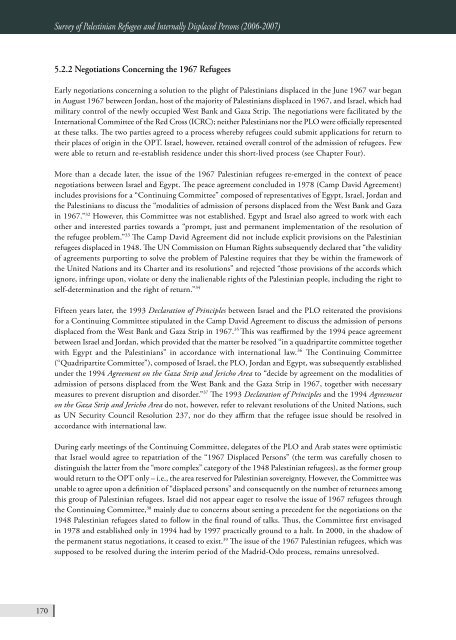BADIL Resource Center for Palestinian Residency and Refugee
BADIL Resource Center for Palestinian Residency and Refugee
BADIL Resource Center for Palestinian Residency and Refugee
Create successful ePaper yourself
Turn your PDF publications into a flip-book with our unique Google optimized e-Paper software.
170<br />
Survey of <strong>Palestinian</strong> <strong>Refugee</strong>s <strong>and</strong> Internally Displaced Persons (2006-2007)<br />
5.2.2 Negotiations Concerning the 1967 <strong>Refugee</strong>s<br />
Early negotiations concerning a solution to the plight of <strong>Palestinian</strong>s displaced in the June 1967 war began<br />
in August 1967 between Jordan, host of the majority of <strong>Palestinian</strong>s displaced in 1967, <strong>and</strong> Israel, which had<br />
military control of the newly occupied West Bank <strong>and</strong> Gaza Strip. The negotiations were facilitated by the<br />
International Committee of the Red Cross (ICRC); neither <strong>Palestinian</strong>s nor the PLO were officially represented<br />
at these talks. The two parties agreed to a process whereby refugees could submit applications <strong>for</strong> return to<br />
their places of origin in the OPT. Israel, however, retained overall control of the admission of refugees. Few<br />
were able to return <strong>and</strong> re-establish residence under this short-lived process (see Chapter Four).<br />
More than a decade later, the issue of the 1967 <strong>Palestinian</strong> refugees re-emerged in the context of peace<br />
negotiations between Israel <strong>and</strong> Egypt. The peace agreement concluded in 1978 (Camp David Agreement)<br />
includes provisions <strong>for</strong> a “Continuing Committee” composed of representatives of Egypt, Israel, Jordan <strong>and</strong><br />
the <strong>Palestinian</strong>s to discuss the “modalities of admission of persons displaced from the West Bank <strong>and</strong> Gaza<br />
in 1967.” 32 However, this Committee was not established. Egypt <strong>and</strong> Israel also agreed to work with each<br />
other <strong>and</strong> interested parties towards a “prompt, just <strong>and</strong> permanent implementation of the resolution of<br />
the refugee problem.” 33 The Camp David Agreement did not include explicit provisions on the <strong>Palestinian</strong><br />
refugees displaced in 1948. The UN Commission on Human Rights subsequently declared that “the validity<br />
of agreements purporting to solve the problem of Palestine requires that they be within the framework of<br />
the United Nations <strong>and</strong> its Charter <strong>and</strong> its resolutions” <strong>and</strong> rejected “those provisions of the accords which<br />
ignore, infringe upon, violate or deny the inalienable rights of the <strong>Palestinian</strong> people, including the right to<br />
self-determination <strong>and</strong> the right of return.” 34<br />
Fifteen years later, the 1993 Declaration of Principles between Israel <strong>and</strong> the PLO reiterated the provisions<br />
<strong>for</strong> a Continuing Committee stipulated in the Camp David Agreement to discuss the admission of persons<br />
displaced from the West Bank <strong>and</strong> Gaza Strip in 1967. 35 This was reaffirmed by the 1994 peace agreement<br />
between Israel <strong>and</strong> Jordan, which provided that the matter be resolved “in a quadripartite committee together<br />
with Egypt <strong>and</strong> the <strong>Palestinian</strong>s” in accordance with international law. 36 The Continuing Committee<br />
(“Quadripartite Committee”), composed of Israel, the PLO, Jordan <strong>and</strong> Egypt, was subsequently established<br />
under the 1994 Agreement on the Gaza Strip <strong>and</strong> Jericho Area to “decide by agreement on the modalities of<br />
admission of persons displaced from the West Bank <strong>and</strong> the Gaza Strip in 1967, together with necessary<br />
measures to prevent disruption <strong>and</strong> disorder.” 37 The 1993 Declaration of Principles <strong>and</strong> the 1994 Agreement<br />
on the Gaza Strip <strong>and</strong> Jericho Area do not, however, refer to relevant resolutions of the United Nations, such<br />
as UN Security Council Resolution 237, nor do they affirm that the refugee issue should be resolved in<br />
accordance with international law.<br />
During early meetings of the Continuing Committee, delegates of the PLO <strong>and</strong> Arab states were optimistic<br />
that Israel would agree to repatriation of the “1967 Displaced Persons” (the term was carefully chosen to<br />
distinguish the latter from the “more complex” category of the 1948 <strong>Palestinian</strong> refugees), as the <strong>for</strong>mer group<br />
would return to the OPT only – i.e., the area reserved <strong>for</strong> <strong>Palestinian</strong> sovereignty. However, the Committee was<br />
unable to agree upon a definition of “displaced persons” <strong>and</strong> consequently on the number of returnees among<br />
this group of <strong>Palestinian</strong> refugees. Israel did not appear eager to resolve the issue of 1967 refugees through<br />
the Continuing Committee, 38 mainly due to concerns about setting a precedent <strong>for</strong> the negotiations on the<br />
1948 <strong>Palestinian</strong> refugees slated to follow in the final round of talks. Thus, the Committee first envisaged<br />
in 1978 <strong>and</strong> established only in 1994 had by 1997 practically ground to a halt. In 2000, in the shadow of<br />
the permanent status negotiations, it ceased to exist. 39 The issue of the 1967 <strong>Palestinian</strong> refugees, which was<br />
supposed to be resolved during the interim period of the Madrid-Oslo process, remains unresolved.

















